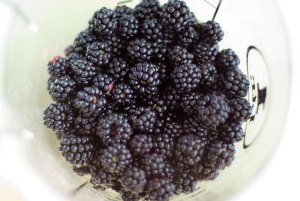
My grandma was from Southern Germany and was always very strict on traditions. Every – I mean every – Sunday there would be a huge roast on the table, alongside with a little salad, lots of gravy and spaetzle. As my family lived some hundred kilometers away, those Sunday feasts were quite a rare thing that I looked forward to. In total contrast to my dad who grew up having a roast on Sundays and having to eat the rests throughout the following week.
But I was a fan of those spaetzle which my grandma made every time from scratch and with the most time-consuming method possible. This was by smearing a thin layer of dough on a cutting board and then kind of scraping the dough off with a large knife so that long strips are formed and fell directly into the boiling water. Every Swabian “hausfrau” is proud to make spaetzle that way and everybody daring to use other, less tedious methods would not be accepted as a good housewife.
Sometimes I still get the craving for a Sunday roast and spaetzle, but if I’m making spaetzle for more than one person, I leave the traditional scraping method behind and go for the pressing method. Either through a colander by scraping with a large silicone spatula or a press – think potato ricer but with bigger holes.
Oh, and if you’re not a fan of Sunday roasts and gravy (read: vegetarian), stack them into a large bowl with Emmental cheese and roasted onions and heat it up until the cheese melts. Serve with some fresh salad and you have really nourishing soul food.

SPAETZLE
for 2 as a main course, for 4 as side dish
300 g / 2 1/2 cups / 10.5 oz flour
3 eggs
250 ml / 1 cup water (or milk and water mixed)
salt and pepper
nutmeg, freshly ground
butter
fried onions

Weigh out the flour and make a little well. You don’t have to be 100 percent exact here, but I’m a little manic that way. That’s why my other electronic scale has increments of 0.1 grams. For measuring out really small quantities like baking powder and such.
In this case, it’s not really important to weigh out the flour. In fact, my grandma just scooped out some handfuls depending the amount and size of the eggs.

Measure out 1 cup of milk and water mixed – no special ratio needed. Personally, I like 50/50, but if you’re lactose intolerant, skip the milk and use only water.
+++ EDIT +++
According to my aunt and uncle, you should only use water – if you use any. My aunt uses only eggs and flour, adding just enough water to give the dough the right consistency.

Now add the eggs, milk/water mixture as well as the spices (salt, pepper, nutmeg) to the flour and start stirring with a large wooden spoon. I know, it will be lumpy at first. But don’t be tempted to reach for the hand mixer. You need to beat it by hand, otherwise they will be hard and rubbery if you overbeat the dough with a machine.
So the first secret is – elbow grease…

Beat the heck out of it until it looks mostly smooth, sticks to the bowl and flows like thick lava from your spoon.
Now comes the tricky part where it is impossible to make pictures without getting dough on your camera. This is sticky stuff.

Bring a pot with salt water to boil and have a colander, your largest rubber spatula, a slotted spoon and a bowl with ice water ready.
Set the colander on top of the pot. Before you start anything else, check that the colander sits a couple of inches above the water. Now ladle in a big spoonful of dough and press it through the holes with the rubber spatula. Remove the colander from the pot and fish out all the swimming pasta strands and put them into the ice water. Check their size. If you think you want them longer and thinner, add some more water, if you want them small and stubbly add some more flour. Repeat pressing batches of dough through the colander until you have used it all up.
It’s important to get them out as soon as they float to the top, or else you will get rather hard and chewy pasta. You might have guessed it – that’s the second secret.
Or, if you happen to have a potato ricer with interchangeable hole plates, then take the one with the biggest holes.

Melt some butter in a casserole and gently cover all the pasta with butter, while reheating it. You can also place the hole thing into the oven and reheat it gently in there. Just be sure to put in enough butter, or all will be sticking together.

Now top it off with fried onions and more butter. Serve with your favorite pot roast or gulasch.
By the way, on the photo above you see the leftovers I layered in there with cheese and heated it up the next day in my company’s microwave. That was a satisfying lunch!








































































